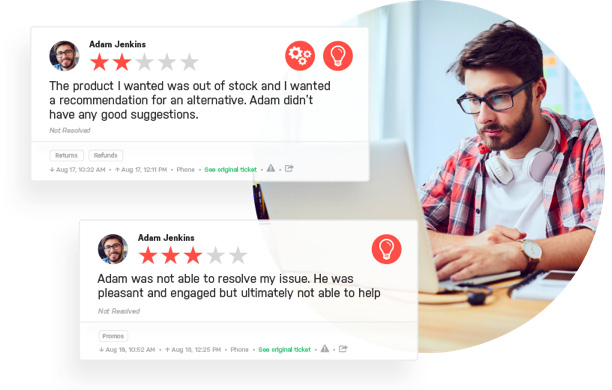What is Customer Feedback? Definition + Examples
August 18, 2020
Contact Center
Customer feedback is the verbal or written communication from your customers expressing how they feel about your brand, your products, and/or the service they received from your team.
There’s a famous saying that goes, “Feedback is the breakfast of champions.” And when it comes to customer feedback, breakfast should always be a buffet.
Customer feedback is an invaluable asset for businesses of every size and type; software companies use it to fix bugs and build new features, retail companies use it to audit their shipping practices or inventory stock, and restaurants use it to inform changes to their menus or dining experience.
Let’s break down how to define customer feedback for your business, with examples of different types of customer feedback your business might receive from customers.
Customer Feedback Defined
Customer feedback can take many forms – social media posts where customers tag your brand (either to sing your praises or to vent their frustrations), word-of-mouth exchanges between prospects and current customers (which is a nearly impossible method to track), and surveys your brand can send out after interactions with your customers to gauge their happiness with your products or services.
How your brand chooses to collect (and use) customer feedback is up to you. And in the world of customer service, there are a myriad of ways you can utilize customer feedback.
Collecting input from your customers can not only be used to help improve how customers feel about your brand or your products, but also to improve how your service team performs, how engaged your front-line agents are, and how you coach and train your team to handle future customer inquiries.
For example, you can use quarterly NPS scores to track overall brand sentiment from your customers, and review any additional commentary provided by your customers to fine-tune different parts of your organization.
Types of Customer Feedback
Customer feedback comes in many shapes, sizes, and flavors (some spicier than others). But each one is important for your agents, your CX organization, and your business as a whole to pay attention to, act on, and utilize.
Let’s break them down:
Example 1: the numeric NPS response
Everyone loves a handy dandy NPS survey. They give you an easy glimpse into how your customers are thinking about your brand or your business, and quantify just how happy they are with your services.
But, not all NPS surveys or responses are created equal.
Let’s say your business sends out an NPS survey to a random sample of customers. Of that sample, 65% are promoters (and gave you a 9-10 rating), 25% are neutral (a 7-8 rating), and 10% are detractors (a 0-6 rating). Of that sample, only a handful of the promoters wrote feedback about why they picked the score they did. The rest simply clicked a number and then went about their day.
Where do you go from here? How can you convert those neutral customers into promoters, and raise the bar for the detractors to bring them closer to your ideal score without written feedback?
NPS is helpful, but only when it gives you a clear picture of what your customer was thinking and provides tangible feedback you can incorporate into your organization.
Example 2: a “yes” or “no” response to an FCR survey
Now, let’s say every time a customer creates a Support ticket, your organization sends an automated First Contact Resolution survey once the ticket is closed.
Most often, a FCR survey is just one question – Were we able to help you resolve your issue? – with a simple “yes” or “no” response.
Receiving a “yes” is, of course, great – it means your agents were able to help your customer get to the bottom of their issue and helped make their day a little better. Receiving a “no,” on the other hand, is the exact opposite; it means your agents weren’t able to successfully meet the needs of your customer, and they’ve been left frustrated by the experience, with their issue still unresolved.
So what happens after a “no”?
Depending on what you use to capture FCR. it could be nothing. “No” responses are simply filed away in a folder, maybe you ping your agents to get more context on the particular issue, and everyone pretends it didn’t happen.
If you want to turn those “no” responses into actionable customer feedback, however, it’s crucial to have tools for your business like Service Recovery.
With Service Recovery, you have the ability to flag any “no” responses and fire off a follow-up survey to your customer, get more clarity from them on how you missed the mark, and dig in deeper to resolve their issue.
Plus, you get the added benefit of being able to re-survey your customers, which means even more insight for your team on the value of being able to circle back on negative FCR responses.
Win, win, and win.
Example 3: Social media beef/praise
Not every customer is a happy customer.
Try as we might, there are going to be some customers who feel let down by your brand, and take to social media to vent their frustrations. If your brand has an account on their chosen platform, they’re likely to even tag you so that your marketing team (as well as all of their followers) can see their concern.
When this happens, you have a few options. You could:
- Rely on your marketing team to reply and quell the angry customer.
- Monitor incoming customer complaints via social media, but refrain from responding to draw negative attention to them.
- Have a dedicated Support page on each social media platform to reach out when customers share negativity about your brand.
If your brand is leaning toward any option besides 3, it’s time to take a step back and re-evaluate how you think about customer feedback on social.
Take this research by Sprout Social as proof: in a recent survey, nearly 50% of respondents reported that they would boycott a brand as a result of a poor interaction on social media.
That means that for every angry customer tweet, or LinkedIn post, or Instagram comment, 1 in 2 of those customers will stop supporting your brand. Can your brand afford to lose that many customers over an unanswered question or comment?
For most of us, the answer is no.
That’s why in today’s digitally-savvy world, having a strategy for providing customer support via social media is crucial. Your support organization needs to have a plan for how to quickly and effectively address customer concerns, ensure that their needs are met, and publicly acknowledge when your brand has made a mistake.
Doing so will not only help that specific customer, but will show others who follow your brand that you take negative customer feedback seriously and want to serve your customers in the best way possible.
Now, with all the potential negativity that could come in via social media, there’s a silver lining.
Word-of-mouth is such an important way that consumers find out about your brand, and happy customers are more likely to sing your praises on their social channels. Don’t just keep track of the negativity; be sure to monitor incoming positive customer feedback across all of your social channels.
Example 4: Public reviews
Nearly every business gives customers the ability to provide public customer feedback in some way.
For software companies, reviews on G2 act as a way to share their insight on how a particular technology has helped (or, not helped) their business.
For retail companies, product reviews serve as an avenue for customers to not only share their opinion of what they purchased, but also provide feedback on the company as a whole.
Whatever type of business your company is, public avenues like review sites and review sections on your own site are important for your team to monitor.
Take retail, for example. If a customer shares a negative product review that is left unanswered by your team, their review could end up discouraging other potential new customers from purchasing the same product.
Instead, take the lead when it comes to feedback left by customers on public spaces. Ensure that a member of your team is always able to monitor these channels, and respond appropriately.
Maybe instead of reaching out to your Support team about a damaged item, a customer chooses to leave a review – this is a great opportunity for your team to step in, give them the option to get a full refund or replacement item, and own the situation for other customers to see.
Example 5: a complete CSAT survey
When it comes to customer feedback for service organizations, CSAT scores typically reign supreme.
After all, it makes sense: customer satisfaction, or CSAT, can be seen as the end all, be all metric of whether or not a customer is happy with your brand, your services offered, and even your individual agents that they interacted with.
But just like NPS surveys, not all CSAT surveys are the same.
When you ask customers how satisfied they are, it’s important not to just provide them with a sliding scale of 1-5, but to also give them an avenue for providing written feedback as well.
With Medallia Agent Connect, you can capture agent-level customer feedback with both quantitative and qualitative measures.
Take the example below – Adam has received two relatively low ratings from recent customer interactions. Without the ability to provide feedback about their score, him and his manager may have not been able to pinpoint the issue.

In the two star review, it seems as though Adam simply isn’t as familiar with the company’s product offerings as he could be, and might need to go through additional product training to familiarize himself with all available SKUs. In the second, while it seems like Adam does his best to be professional and friendly, he missed the mark on resolving the customer issue in a timely manner.
These examples not only give the customer the ability to voice their concerns and feel like they’re being heard, but also provide Adam and his manager with concrete insight into his performance and action items for how to help him improve.
Why Agent-Level Customer Feedback is Important
Sometimes, customer feedback is as simple as a numeric response to a question about how likely someone is to recommend your brand to friends or family. Other times, it’s a “yes” or “no” in response to whether or not you helped them solve a problem they reached out about.
But ultimately, customer feedback should be at the core of every business because, ultimately, it’s pivotal to enabling your customer service team to succeed.
For Adam, a handful of negative customer feedback reviews without any additional context could have meant the end of his time at his company. But, because his organization runs their CSAT surveys using Medallia Agent Connect, he’s able to get real-time feedback from customers that digs a big deeper.
As a result, instead of just seeing low reviews, he can see reviews that pinpoint how he missed the mark. With that additional insight, he can work with his manager on coaching opportunities or additional training that get to the root of the customers’ concerns.
When you let customer feedback guide your coaching efforts, you’ll never miss another opportunity for improvement.
Ready to ignite agent performance? Check out Medallia’s guide, 4 Steps to Supercharge Contact Center Agent Performance, to learn how leading contact centers are putting the right systems and processes in place to achieve success.










